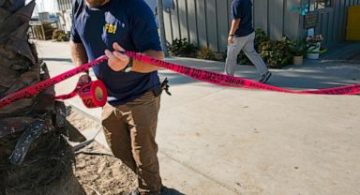A wealthy stock trader engaged in “extreme risk-taking behavior” before a fire broke out in his Maryland home and killed a man who was helping him dig tunnels for an underground nuclear bunker, a prosecutor said Tuesday at the close of the millionaire’s murder trial.
Before jurors began deliberating, Montgomery County prosecutor Marybeth Ayres said 27-year-old Daniel Beckwitt created the “death trap” conditions that prevented Askia Khafra from escaping the house.
But a defense lawyer who described Beckwitt as a “very strange young man” nevertheless urged jurors to acquit him of second-degree murder and involuntary manslaughter charges in the September 2017 death of the 21-year-old Khafra.
“Being different, living in a different circumstance, is not a crime,” defense attorney Robert Bonsib said during the trial’s closing arguments.
Ayers acknowledged that Beckwitt didn’t cause the fire that killed Khafra, but she said the house was filled with piles of garbage and clutter, some almost reaching the ceiling and covering most of the floors.
“This is not an intentional murder,” Ayres said. “You don’t need to prove an intent.”
But Bonsib said, “An accident is not a crime.”
Jurors must decide between those alternatives: crime or accident.
Beckwitt didn’t testify before prosecutors and defense lawyers finished presenting evidence from witnesses last Wednesday.
The fire erupted in the basement as Khafra was digging tunnels lower down under Beckwitt’s home in Bethesda, a Washington suburb. His body was found in the basement, only a few steps from an exit.
Beckwitt went to elaborate lengths to keep the project a secret. He tried to trick Khafra into thinking they were digging the tunnels in Virginia instead of Maryland by having him don “blackout glasses” before taking him on a long drive. Beckwitt also used internet “spoofing” to make it appear they were digging in Virginia.
Hours before the fire broke out, Khafra texted Beckwitt to warn him it smelled like smoke in the tunnels. Ayres said Beckwitt didn’t respond for more than six hours before telling Khafra that there had been a “major electrical failure.” Instead of getting Khafra out of the tunnels, Beckwitt told him that he “just switched it all over to another circuit,” according to the prosecutor.
Ayres said Beckwitt sacrificed safety for secrecy.
“This was a survivable fire, and we know that because the defendant survived,” she said.
Bonsib said Beckwitt screamed for help from neighbors after the fire broke out and risked his own safety in a failed attempt to rescue his friend from the blaze. The defense attorney said there is no evidence, only speculation, to explain why Khafra died in the fire that day.
“This case is a mystery without an answer,” Bonsib said.
Khafra met Beckwitt online. Beckwitt had invested money in a company Khafra was trying to launch as he helped Beckwitt dig the tunnels.
Firefighters found Khafra’s charred, naked body after entering the home. A hole in the concrete basement floor led to a shaft that dropped down 20 feet (6 meters) into tunnels that branched out roughly 200 feet (60 meters) in length.
Bonsib said nothing happened in the tunnels that endangered anyone’s life.
“They may be weird. They may look weird. But they were solid as a rock and they were a safe environment,” he said.
Khafra worked in the tunnels for days at a time, eating and sleeping in there. They had lights, an air circulation system and a heater.
Bonsib said Khafra was a willing participant in the project. He showed jurors a “selfie” photograph that Khafra posted on social media, showing him in the tunnels.
Prosecutors have described Beckwitt as a skilled computer hacker who had a paranoid fixation on a possible nuclear attack by North Korea. In 2016, Beckwitt spoke at a hacker convention using the alias “3AlarmLampscooter” and wearing a fire-resistant suit and visor that obscured his face. Another prosecutor, Doug Wink, has said Beckwitt was teaching his audience how to make thermite bombs to destroy computer data “in order to get away with hacking.”





